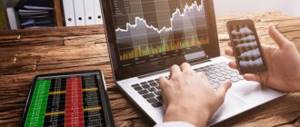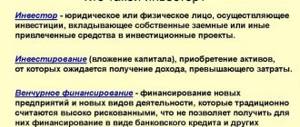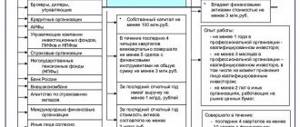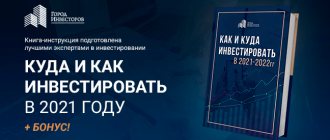Bill Williams
Bill Williams, the author of this strategy, was born in 1928 and began trading in 1959. He was then working as a teacher at a business school in Florida, and he took ideas for transactions from a professor in the accounting department, essentially completely copying his actions on his own account. After trading like this for almost 21 years, the former teacher decided to take up professional trading. But, unfortunately, independent trading did not bring a positive result. Only after losing a lot of money trading on other people's information tickets (signals), Bill began to independently research the market, as a result of which he came to the Profitunity strategy, which we will discuss below.
Bruce Kovner
Bruce Kovner was born in 1945 in Brooklyn, New York.
Bruce began his career in financial markets very late, only in 1977, when he was already 32 years old. He financed his first investment with money from his credit card - soybean futures, on which he made $20,000.
He later joined the Commodities Corporation as a trader and gained a reputation there as a successful and profitable trader, earning millions of dollars for his employer. In 1982, he founded alternative management Caxton, which grew into the world's top hedge fund with $14 billion under management.
Managed capital divided between the commodity and foreign exchange markets has made Kovner one of the largest Forex players in the world. He retired in 2011.
The market is the sum of opinions
The market, according to Bill Williams, is actually very simple. Essentially, the market is the sum of the opinions of all investors. Traders trade on different timeframes and use different goals: for some it is important to make a profit, while others simply hedge risks. In the case of Forex, it may be a simple need for currency. And all these players see a different picture of the market, which forms individual movements, trends, etc.
If you remove the time frame display from the chart, you are unlikely to guess which time period the chart belongs to. Our perception of reality is very relative and depends on which point of view we are currently using. One of the author's conclusions is that all trends in the market change direction accompanied by a higher fractal number than the bars leading to a change in trend. In other words, this suggests that all time frames in the market are connected - the trend changes first on the lower time frame, and then on the higher one.
William Delbert Gunn
William Delbert Gunn was born June 6, 1878 in Lufkin, Texas and died June 18, 1995. He comes from a farming family - his father was involved in growing cotton. Gann was a very religious man - he believed the Bible to be the greatest book ever written, which can be seen in all of his publications.
He was also a 32nd degree Scottish Rite Mason. It is believed that it was from here that Gann gained knowledge about ancient mathematics and the culture of ancient Greece and Egypt. First of all, William Delbert Gann was a trader who, based on his experience, mathematical relationships and ancient mathematics, geometry, astronomy and astrology, developed methods for predicting market changes, later called Gann squares, Gann angles, etc.
Bibliography of William Gunn:
- Truth of the Stock Tape (1923)
- Tunnel Thru The Air (1927)
- Wall Street Stock Selector (1930)
- New Stock Trend Detector (1936)
- Face Facts America (1940)
- How to Make Profits in Commodities (1941)
- How to Make Profits Trading In Puts And Calls (1941)
- 45 Years in Wall Street (1949)
- The Magic Word (1950)
Gann was able to achieve exceptional ROI several times before becoming a renowned trader and analyst. In 1908, within 30 days, his account, which initially contained 130 US dollars, grew to 12 thousand dollars. In 1923, within 60 days, he raised his capital from $973 to $30 thousand. In 1933, he could boast of such efficiency - out of 479 open transactions, 422 were closed with a profit, which gave an efficiency of 88% and a profitability of about 4,000%.
Energy Market Principles
1. Market energy always moves along the path of least resistance. A comparison can be made with a river that makes its way through natural obstacles.
2. Usually, this path is determined by a structure invisible to the eye. Just as the behavior of a river depends on the underlying structure of the channel. The formation of the path is influenced by your own vision of the market.
3. The basic structure is modifiable. Sometimes it seems as if most traders are trying to scoop up all the water from the river with buckets just to change the vector of its movement. Many people simply forget that you can easily change the direction of the flow by moving a stone at the source of the river. That is, our views on the market can always be rethought.
Since the market is the product of many minds, understanding what drives price changes provides a significant trading advantage. Therefore, the Holy Grail is to want what the market wants.
Andy Krieger
Andy Krieger is a trader who worked for the investment bank Salomon Brothers and one of the largest US banks of the 20th century, Bankers Trust.
He joined Bankers Trust in 1986 and quickly gained a reputation as an excellent trader. Thanks to Edney, his employer raised his managed capital limit by $700 million from the standard $50 million.
His most successful deal occurred on October 19, 1987, the so-called Black Monday. In October 1987, the Dow Jones index fell 22.6%, so investors began to invest in other, more stable assets. Andy realized that since everyone invests in everything, there are 1-2 national currencies that are overvalued. Therefore, he focused on the New Zealand dollar, which he considered an excellent currency for short selling in case of panic in global financial markets. During this crisis, Andrew Krieger used a 1:400 leverage on his allocated capital and thereby opened a short position on the NZU/USD pair worth more than the then money supply in New Zealand (the country's Central Bank was not ready for this, so the exchange rate decreased by 5%). According to preliminary estimates, between 30 and 40 million US dollars were actually invested.
This deal made Andy $300 million for Bankers Trust. To stop the financial attack, the head of the Central Bank of New Zealand called and threatened the heads of the American bank.
In 1988, Andy Krieger resigned from Bankers Trust and got a job at the D. Soros Foundation. Later, he told reporters that he quit because of a feeling of resentment - she earned 300 million dollars for the bank, but received only 3 million in gratitude.
Types of people
* Traders - feel best in the role of Columbus (conquerors). They have a tendency to think independently and act against conventional wisdom. Usually bold leaders who attract other investors.
* Investors – feel comfortable following in the footsteps of traders. The success of investors usually depends on the success of the leader - the trader.
* Savers are people who are afraid to take on unnecessary risks and obligations, so they invest money in deposits and pension plans (a common scheme in the USA). Such people will not change the current state of affairs, even despite the unsatisfactory result.
Assess the level of risk
Many beginners are drawn to high-risk strategies. And it’s not surprising, because they provide a chance to pump up capital very quickly. But this chance is very small, but the risk of losing the deposit is off the charts. Cold-blooded professionals who have allocated a small part of their capital to “extreme” can work with such strategies. According to the principle “if I win, it will be cool, if I lose, it’s not scary.”
For a beginner, it is better to choose a low-risk trading approach. The main task of a novice trader is to learn how to preserve capital. Therefore, work with conservative strategies and test your financial pain threshold to determine your personal risk comfort level.
Ladder to profit
- Level – novice trader. His goal is to take money while gaining new experience. During this stage, the basics are taught: how to place a trade, how to correctly calculate the margin, and so on.
- Level – advanced beginner. The goal is to make money gradually using a small account.
- Level – advanced trader. The goal is to maximize overall ROI. The trader already knows how to feel the “tact” of the market and determine which strategy is most suitable for the current state.
- Level – experienced trader. The goal is to trade in accordance with one's own belief systems. Stability comes to the fore, and winning becomes the main goal.
- Level – expert trader. The goal of an expert trader is to trade using a state of mind. At this stage, there is a complete understanding of yourself and the market. The concept of randomness no longer exists, and any chaos has a certain order.
Neil Fuller
Nial Fuller is a profitable trader, trainer and author of widely understood trading techniques. He has over 12 years of financial experience. He is an expert in price action trading.
Since founding his blog in 2008, Nial Fuller has been the most popular Forex trader in the world, with over a quarter of a million monthly readers. You can find more about Price Action here.
Strategy rules
Any trading platform is suitable for a trading system, since Bill Williams indicators have long become a standard and are available in any terminal. The strategy can be applied on any timeframe, but the author of the strategy recommends the daily chart.
The Profitunity system consists of indicators: Alligator, Awesome Oscillator (AO) and Fractals. The “Bullish/Bearish Reversal Bar” pattern is also used. There are 3 input signals, each of which Bill Williams calls a “sage”.
You can enter using any of 3 types of signals, but the most significant are the signals from the bullish/bearish reversal bar and the AO oscillator. It is more advisable to use signals for entering fractals only for adding to a position.
Ray Dalio
Raymond Dalio is an American investor and billionaire, hedge fund chairman and philanthropist. Dalio is the founder of the investment firm Bridgewater Associates, one of the largest hedge funds in the world. In January 2021, he was on the list of the 100 richest people in the world (according to Bloomberg).
“I believe that the biggest problem of humanity is emotional sensitivity in situations where we find out whether we are right or wrong, and determine our strengths and weaknesses.”
This quote is very profound for several reasons. First of all, sensitivity is highly undesirable in trading. If you worry too much about every losing trade, you will start making a series of serious mistakes. Secondly, whether you are right should be 100% irrelevant to you. According to Mark Douglas, you can be wrong more often than you are right and still make money. Ultimately, you must identify your strengths and weaknesses before you can succeed in trading. Our personality influences our trading, and this influence can be both negative and positive.
Alligator
Essentially, the alligator represents 3 MAs (moving averages).
- The blue line is a 13-bar MA, with an 8-bar shift. Essentially, it displays where the price would be in the absence of chaos. The size of the range between the jaws and the actual price speaks to the players' interpretation of this new input.
- The red line is an 8-mbar MA, with a 5-bar shift. This line also shows equilibrium, but for a smaller time frame. This timeframe is equal to approximately a fifth of the time period of the chart. That is, if you are trading on a daily chart, the line will approximately reflect the situation on a four-hour chart.
- The green line is a 5-bar MA, with a 3-bar shift into the future. Again, the green line corresponds to approximately one-fifth of the temporary tooth structure (red line). That is, it is closest to the period H1 or M30.
Together, all three lines - jaws, teeth and lips form the alligator's mouth.
Alligator is an advanced trend indicator. Obviously, moving a blue line requires more information than moving a red or green line. The system uses the default indicator settings.
First Sage – Bullish/Bearish Reversal Bar
The next part of the system is a bullish or bearish reversal bar. This is the first signal to enter a trade. Today, to achieve success in the market, it is not enough to simply “buy and hold,” to quote the book, one must also take into account the short-term desires of the market. Therefore, we will look for the earliest indication of a trend reversal.
A bullish reversal bar makes a lower low relative to the previous bar and closes above its midpoint. This suggests that at the beginning of the formation of the bar, the forces were on the side of the bears, but then power passed to the bulls.
In contrast to a bullish bar, there is also a bearish reversal bar. This bar makes a new high and closes in its lower half. That is, in the beginning the bulls ruled, but in the end the bears won.
The bar for both a bullish and bearish reversal must be located at a significant distance from the Alligator lines. Also, the angle formed by the price must be greater than the angle formed by the alligator's mouth. We enter a short just below the low of the bearish reversal bar and place a stop just above its high.
The same thing, only in reverse, is true for a bull market. We enter a buy position just above the high of the bearish reversal, and place a stop at some distance below the low.
Second Sage – Awesome Oscillator
The next stage of the system is the AO oscillator. The indicator measures the momentum over the last 5 bars and compares this value with the last 34 bars. That is, the indicator displays the current strength of the impulse.
The signal for adding to an open position is three consecutive bars of the same color on the AO histogram. At the close of the third bar, we place a pending order just below the low of the candle and set a stop loss by analogy with the first signal in the system - near the high of the same candle.
In the book “Trading Chaos” the author advises using this signal as an additional one, that is, for topping up. However, if there was no reversal bar, we may well enter a trade using the AO indicator, but with a smaller lot size.
Third Sage – Fractals
For the third signal in the classical strategy, fractals are used. Ideally, an ascending fractal is at least five consecutive candles, where the highest high on both sides is accompanied by two lower highs. The same is true for a downward fractal, where the smallest low is followed by four bars with higher lows. In the case of ascending fractals, we are interested only in the maximums of the bars, in the case of descending fractals, only in the minimums. A fractal does not have to consist of 5 candles; the shapes can be quite different:
We place the next pending order on the opposite side of the alligator’s “mouth”. When a fractal appears, we place a pending buy order. It is important that at the time of execution, the order is behind the red alligator line. If the fractal is triggered, we also enter on subsequent fractals until we have a total of 5 orders. We place a stop loss at the low bar of a fractal candle, or at the high of the last 3-5 candles. A fractal can also be the first signal in the system if there were no signals from the reversal bar and the AO indicator. If this is the first signal, we enter with the minimum lot.
Paul Tudor Jones
Paul Tudor Jones' pre-Black Monday short is one of the most famous deals of all time. Based on charts, Paul Tudor Jones predicted in 1986 that the market was headed for a huge crash. In fact, the crash occurred in the fall of 1987 and was the largest single-day (percentage) decline in the U.S. stock market. Jones reportedly tripled his money and made nearly $100 million as the Dow Jones Industrial Average fell 22%. He made a fortune while many other traders failed. His funds have produced systematic profits for decades.
Quote from the book “Market Wizards” (New Market Wizards: Conversations with America's Best Traders):
“...this was the first time I learned the discipline and management of money. It was a cathartic experience for me in the sense that I was already on the verge of collapse, questioning myself as a trader, but I decided that I would not give up. I was determined to come back and fight. I decided to become very disciplined and treat trading like a business.”
Here Jones is saying that if a trader at some point makes a huge mistake in money management, then he will have to look at himself and decide what to do next. Will he continue to lose and continue to make poor risk management decisions? Or will he decide to eventually become disciplined like a businessman? Money management determines your trading destiny (literally), so you need to pay close attention to it early on if you want to have any chance of success
When the wise men gather together
Now that we understand what all three wise men's signals are, it's time to put them all together:
- The first sage signal is formed at a fairly large distance from the alligator. a bullish or bearish reversal bar to appear . The purpose of the first signal is to enter the market at the best price with the minimum level of losses. Here it is worth paying special attention to the presence of a steeper price slope relative to the alligator lines (good angulation), especially in relation to the blue line – the jaws;
- After entering the market, we look for a suitable place to top up. If the market continues to move in our direction, we begin counting bars on the AO . After the appearance of three consecutive bars of the same color (green for buy, red for sell), we add to the main position in accordance with the MM system;
- After the second signal is triggered, we begin to look for a point for the third entry, that is, we wait for the conditions for the formation of a fractal - two bars with lower highs or higher lows. The goal of the third sage is to simply follow the trend as long as it goes in our direction. When a fractal appears, place a stop order immediately after the extremum and a stop loss at the lowest low or highest high over the last 3 or 5 bars;
- We continue to monitor the arrival of new signals until the position size reaches its maximum in accordance with the MM (according to the book - a total of 5 orders);
- If the position is not closed by the stop, exit when an opposite signal appears (or flip the position).
Ed Seykota
Based on trend trading, Ed Seykota converted $5,000 into $15 million in 12 years. In the early seventies, Seykota worked as an analyst at one of the largest brokers. Seykota invented and created the first computerized trading system for managing client funds in the derivatives market.
“The fundamental messages you read about usually don't matter because the market has already discounted them. I am first and foremost a trader who follows the trend and my intuition, which I have after more than 20 years of experience in the market. The most important to me are: (1) long term trend, (2) current formation on the chart, (3) a good place to sell or buy. These are the three main components of my trading. Even further down, in fourth place, are my thoughts on fundamental analysis, which brought me more losses than profits.”
Here's what Neil Fuller writes about this:
“I completely agree with what Ed says in the quote above and that is what I teach in my courses. In addition, I focus primarily on following the trend and use intuition, which can only be acquired by spending many hours in front of a computer screen and after proper training. Ed also talks about formations, which to me means Price Action patterns and I'm a big proponent of them.
Choosing a good place to buy or sell is what he describes as merger trading. Finding such a good spot requires knowledge of Price Action and the ability to read the story written on the charts. Ed also mentions fundamental analysis, and like him, I also don't give it much importance because the market usually discounts it right away. In other words, price action reflects all the variables in the market. Price Action gives you everything you need to analyze the market and find entry and exit scenarios with a high probability of success, so don't overcomplicate yourself by trying to analyze every possible variable."
Money Management and Reverse Pyramid
To calculate position sizing, Bill Williams recommends the following approach, which resembles an inverse pyramid:
- Order – lot X
- Order – 5X
- Order – 4X
- Order – 3X
- Order – 2X
It is advisable to set the position size to no more than 0.5% of the deposit for 1X. To calculate the lot size, you can use the lot calculator.
What is a trading style?
Trading style is a set of preferences that determine how often you place trades and how long you keep them open. This will depend on your account size, how much time you can devote to trading, your personality and your risk tolerance.
While your trading style and your trading plan should be unique to you, there are four popular styles that you can choose from.
- Positional trading.
- Swing trading.
- Day trading.
- Scalping.
Examples
Let's look at an example on GBPUSD, period H4. As expected, when a bullish reversal bar appears, we place a pending buy order just above its high. As you can see in the above chart, signals numbered 1 and 2 turned out to be false and the orders were closed with a stop loss.
After opening a position, wait for three green bars to appear on AO and place a pending buy order just above the high of the current candle. After the trend has reversed, we add more when fractals are broken until we get a total of 5 orders.
When a bearish reversal bar appears, close the buy position and immediately open a sell order at the low of the reversal bar. As we can see, despite the fact that we managed to enter the position only on the third attempt, the profit from the captured movement covered the losses of the two previous transactions.
Next, using Sell Stop orders, we top up when a signal appears on AO and when the fractal minimum is broken. We exit in the same way – when a reverse signal appears (in this case, a bullish reversal bar).
Stanley Druckenmiller
Stanley Druckenmiller is an American investor, hedge fund chairman, and philanthropist.
In 1988, he was hired by Soros to replace Victor Niederhoffer at the Quantum Foundation. Stanley and Soros "beat the Bank of England" when they went short and made over a billion dollars in sterling in 1992. They calculated that the Bank of England did not have enough foreign exchange reserves to buy enough to stabilize the exchange rate, and raising interest rates would be politically unjustifiable.
“I learned a lot from Soros, but probably the most important one is that it doesn’t matter whether you’re right or wrong—it’s how much money you make when you’re right and how much you lose when you’re wrong.”
Most traders are too concerned about the number of trades they win and lose, and what they should really be focusing on is the risk/reward ratio.
Conclusion
Despite the fact that initially the strategy was to follow the trend, subsequently entries became much earlier, literally at the first signs of a reversal. According to the author, these changes are due to the fact that markets today have become much more mobile, and therefore require a more aggressive approach.
At the same time, one of the main advantages of the strategy is that even if you catch several stops in a row, the loss will be more than covered by a much larger profit from the trend movement.
The only weakness of the system, in my personal opinion, is its input. But in this case, using additional filters can help. Also, when entering, do not forget to take into account the support and resistance levels - it is foolish to enter directly in the direction of the level. Essentially, markets are an exchange of emotional energy, and the energy takes its final form in the form of money. Therefore, psychology still takes the leading role, and the system and technical/fundamental analysis fade into the background.
Stanley Druckenmiller
Stanley Druckenmiller grew up in a middle-class family in the suburbs of Philadelphia. He began his career in financial markets in 1977 as an apprentice at a bank in Pittsburgh. He achieved quick success, thanks to which, after four years in the financial markets, he opened his own company - Duquesne Capital Management. For several years he was associated with George Soros, managing his funds.
Stanley Druckenmiller had a huge career as a manager at Quantum Fund from 1988 to 2000. His fame came in 1994 with the publication of the best-selling book The New Market Wizards, which included his story. He ended his career in 2010, two years after the start of the last financial crisis.
Kerry trade
Carry trade is used by many large companies around the world to generate significant interest income. Essentially, you buy a currency with a higher interest rate and sell a currency with a lower interest rate.
So, for example, if the Australian dollar has a 4% interest rate and the Japanese yen has a 1% interest rate, then buying the AUD/JPY pair will give a net 3% interest rate and this is considered a positive carry trade.
On the other hand, if you sold the AUD/JPY pair, you would pay a 3 percent interest rate. This is considered a negative trade. Traders should be aware of the impact of carryover trades when they buy and sell currencies because negative costs can sometimes eat up potential profits above expected returns.
You may be wondering why such a low interest rate would be attractive? It is important to remember that with this trading technique you can earn multiples of the difference in interest rates. For example, based on the 3% we mentioned earlier, a position with 1:10 leverage could potentially earn 30% per annum.
Now, although a carry trade sounds like a no-loss trade, the reality is that you should still be aware of potential market fluctuations while you hold your position. Depending on whether the market moves in the direction of a positive carry trade, you can make a profit or loss that exceeds the interest rate differential.
Essentially, the best carry trades are those that not only have an attractive interest rate differential, but also a positive market bias in the direction you choose.
Position trading
Position trading involves holding a trade for an extended period of time, be it weeks, months or even years. Position traders don't worry about short-term market fluctuations—instead, they focus on the overarching market trend.
Investing is perhaps the most popular form of positional trading. However, an investor will most often use a buy and hold strategy, while position trading can also apply to shorter positions.
Positional trading involves taking fewer trades than other trading styles, but the positions will tend to have higher value. While this increases the potential for profit, it also increases the trader's exposure to risk. Position traders must have a lot of patience to adhere to the rules laid out in their trading plan. They need to know exactly when to close a position and when to let profits run.
Typically, position traders will rely on technical analysis and global support and resistance levels.
Copying cryptocurrency trades
Everything about cryptocurrencies is still at an early stage of development - no one knows what place they will occupy in our lives in 20 years. However, the deeper I dive into the topic, the more convinced I am that everything is developing very quickly and advanced technologies (including investment) are used. True, unlike the stock market, which grows 80% of the time, the cryptocurrency market experiences a crisis every 2-3 years and it is difficult to invest in it for the future - there are no guarantees of long-term growth.
Article on the topic: What is Bitcoin cryptocurrency and how to make money on it?
On the other hand, cryptocurrency trading allows you to make money on both growth and decline, and is generally quite popular, so the emergence of services for copying crypto traders’ transactions was not long in coming. Today we will look at two popular platforms for copying crypto traders' trades - Zignaly and Coinmatics.
To start copying cryptocurrency trades, you need an account on a crypto exchange. Binance is the best choice - it is supported by all services.
Copying trades of Binance traders on Zignaly
Z ignaly.com is the first service for copying transactions of cryptocurrency traders, which began operating in 2019. At the moment, about 100 traders are ready to broadcast signals. There is no copying fee, but most strategies are only available with a paid subscription. In this regard, the company’s second product, the Profit Sharing system for subscribing to traders, looks like a more interesting option. In fact, this is a local analogue of PAMM accounts - according to this scheme, the trader also manages the entire pool of investments and receives a % of investors’ profits.
The minimum deposit for copying depends on the trader, starts from 100 USDT ($100), sometimes the account currency is Bitcoin (BTC) or Binance Coin (BNB). Paid subscriptions for traders start from $5 per month.
Interesting Zignaly traders: Omega Algorithm, Trade Sniper – Usdt Binance, Alpha
Copying trades of Binance traders on Coinmatics
Coinmatics.com is a service for copying transactions of crypto traders, which began operating in 2021. Interestingly, it is being developed by a Russian-speaking team. The site is still in beta and is gradually gaining functionality. At the moment, we have managed to attract 125 traders (it is too early to talk about the age of the strategies simply because the service has just launched). It’s also difficult to talk about the quality of strategies, but in the conditions of the cryptocurrency boom they bring profit, there is plenty to choose from.
The minimum deposit is 150 USDT, i.e. 150 dollars. Some traders charge a monthly fee, in which case the actual minimum deposit will be $1000 or more. There are also free signals.
Interesting Coinmatics traders: Crypto BTC+ALTs, Binance signals, Gold Alts.
The crypto market is just developing, but active stock market traders have been trying to beat the indices for many years. And their deals can be copied too!
High Frequency Trading
High frequency trading is an algorithmic trading method that large organizations use to execute huge numbers of orders in a matter of seconds.
However, this style is not generally classified as a mainstream trading style because it relies on core technology rather than the trader's personal preference or plan to execute trades. High frequency trading is also not widely available to individual traders, meaning they simply cannot keep up with the big companies.











